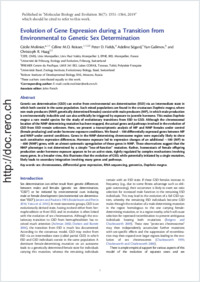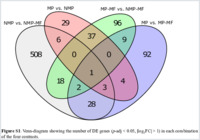Evolution of gene expression during a transition from environmental to genetic sex determination
- Molinier, Cécile CEFE, CNRS, Univ Montpellier, Univ Paul Valéry Montpellier 3, EPHE, IRD, Montpellier, France
- Reisser, Céline M. O. CEFE, CNRS, Univ Montpellier, Univ Paul Valéry Montpellier 3, EPHE, IRD, Montpellier, France - Université de Fribourg, Ecology and Evolution, Fribourg, Switzerland - IFREMER Centre du Pacifique, UMR 241 EIO, Labex CORAIL, Taravao, Tahiti, Polynésie Française
- Fields, Peter D. Universität Basel, Zoology Institute, Evolutionary Biology, Basel, Switzerland
- Ségard, Adeline CEFE, CNRS, Univ Montpellier, Univ Paul Valéry Montpellier 3, EPHE, IRD, Montpellier, France
- Galimov, Yan Koltsov Institute of Developmental Biology, RAS, Moscow, Russia
- Haag, Christoph R. CEFE, CNRS, Univ Montpellier, Univ Paul Valéry Montpellier 3, EPHE, IRD, Montpellier, France - Université de Fribourg, Ecology and Evolution, Fribourg, Switzerland
-
01.07.2019
Published in:
- Molecular Biology and Evolution. - 2019, vol. 36, no. 7, p. 1551–1564
English
Genetic sex determination (GSD) can evolve from environmental sex determination (ESD) via an intermediate state in which both coexist in the same population. Such mixed populations are found in the crustacean Daphnia magna, where non-male producers (NMP, genetically determined females) coexist with male producers (MP), in which male production is environmentally inducible and can also artificially be triggered by exposure to juvenile hormone. This makes Daphnia magna a rare model species for the study of evolutionary transitions from ESD to GSD. Although the chromosomal location of the NMP-determining mutation has been mapped, the actual genes and pathways involved in the evolution of GSD from ESD remain unknown. Here, we present a transcriptomic analysis of MP and NMP females under control (female producing) and under hormone exposure conditions. We found ∼100 differentially expressed genes between MP and NMP under control conditions. Genes in the NMP-determining chromosome region were especially likely to show such constitutive expression differences. Hormone exposure led to expression changes of an additional ∼100 (MP) to ∼600 (NMP) genes, with an almost systematic upregulation of those genes in NMP. These observations suggest that the NMP phenotype is not determined by a simple “loss-of-function” mutation. Rather, homeostasis of female offspring production under hormone exposure appears to be an active state, tightly regulated by complex mechanisms involving many genes. In a broader view, this illustrates that the evolution of GSD, while potentially initiated by a single mutation, likely leads to secondary integration involving many genes and pathways.
- Faculty
- Faculté des sciences et de médecine
- Department
- Département de Biologie
- Language
-
- English
- Classification
- Biological sciences
- License
- License undefined
- Identifiers
-
- RERO DOC 326710
- DOI 10.1093/molbev/msz123
- Persistent URL
- https://folia.unifr.ch/unifr/documents/307905
Other files
Statistics
Document views: 211
File downloads:
- haa_ege.pdf: 112
- FigS1.pdf: 122
- FigS2.pdf: 113
- tables_legend.txt: 37
- TableS1.txt: 37
- TableS2.txt: 39
- TableS3.txt: 39
- TableS4.txt: 40
- TableS5.txt: 41



